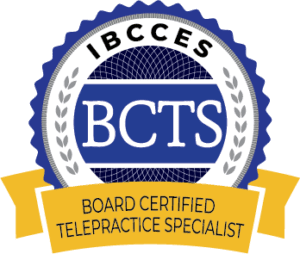
Telepractice or teletherapy has burst into prominence due to many therapists being forced to work remotely due to concerns of COVID-19, and many therapists are realizing the benefits both for their patients and for themselves as a therapist. Even many therapists that were not considering incorporating telepractice before are now being forced to integrate it in order to effectively serve their current clients and attract new ones.
The telehealth industry is something all healthcare professionals should be paying close attention to. The telehealth industry was estimated to grow into a $20 billion dollar industry by 2025 before COVID-19, but with many therapists forced to provide teletherapy the growth of use has changed forever.
While ASHA uses the term to Telepractice because it is the most general term that can be applied outside of healthcare-specific settings, in this article we will utilize both telepractice and the more common term teletherapy interchangeably.
How Different is Teletherapy from Regular Therapy?
Many therapists may not think the transition to teletherapy is that big of a change, and that all they need to do is turn on Zoom and do exactly what they had already been doing. Those therapists will often end up wasting a lot of time with unexpected problems they didn’t know to look out for, reducing confidence of their patients and stakeholders, and causing potentially insurmountable obstacles to effective therapy right at the beginning.
Each first teletherapy session is either an opportunity to establish trust and credibility with using this new medium or an opportunity to undermine it and raise doubts.
The challenge is that doubts in either the patient’s mind or the other stakeholders’ minds can significantly impair progress or openness to teletherapy despite plenty of evidence showing the effectivness of teletherapy.
Don’t let doubt creep in. Make sure you are well prepared to make each first session something that wins over skeptics.
Teletherapy as Supplement to Regular Practice or as a Focus
For most SLPs teletherapy will become a supplement to their already existing practice. For the individual SLP, adding a strong telepractice skillset will increase their value significantly both to themselves and to the clinic they work at.
This is especially true in times where we could be a day away from stay at home orders being issued for health concerns at any time.
Due partially to this uncertainty, teletherapy will forever have an increased footprint from the social distancing measures across the United States and the world and a high need for services from SLPs and audiologists alike.
Need for Accessible SLPs is High Across the Industry
According to research by the American Speech-Language-Hearing Association (ASHA) 69% of speech-language pathologists think that there are either more job opportunities for SLPs than people to fill them (33%) or there was a balanced number of opportunities and applicants (36%). According to the same survey 27% of SLPs said that there were funded but unfilled positions for another SLP at the facility they worked at.
The accessibility of teletherapy along with the fact that there is little evidence to show superiority of in-person methods, is a significant indicator that this form of practice might make more sense for SLPs who want to provide services to more people with less constraints and more flexibility. There is also evidence that teletherapy and in-person treatment result in at least equal outcomes.
Less Than 5% of Speech-Language Pathologists have Proper Teletherapy Training
With all this said, it might be shocking to learn that less than 5% of therapists are properly trained to provide virtual services. Some obstacles still remain with regard to public perception of teletherapy, as according to the International Journal of Speech-Language Pathology:
Parents and other stakeholders know that therapists are trained in how to do therapy. They are looking for reassurance that their practitioners are also proficient in getting results through teletherapy similar to those from in-person services.
It is understandable that parents are concerned about this, as cost for telehealth services is often very similar or identical to in-person services, so why shouldn’t they expect the same results?
How to get Stakeholder and Patient Buy-In for Teletherapy?
For professionals who want to strengthen their skillset and differentiate themselves in the telehealth industry, board certified can both provide that solid foundation of knowledge and preparation for the SLP to effectively administer therapy that gets results and shows the parents and other stakeholders that they are proficient.
Parents and stakeholders typically have very little information to tell if their therapist has put in sufficient effort into understanding how teletherapy is different from in-person therapy and how to adapt as needed to achieve those same results.
A certification from an independent credentialing organization can help therapists ensure they are proficient in teletherapy and show their commitment to parents, patients and other stakeholders alike.
 What is a Board Certified Telepractice Specialist?
What is a Board Certified Telepractice Specialist?
A Board Certified Telepractice Specialist, or BCTS, is a therapy provider who has undergone a board certified program in order to provide the most optimal telepractice experience to their patients while improving outcomes.
Starting to use telepractice entails its own rules and protocols and a BCTS will be well informed on the tools they need in order to deliver virtual services successfully and seamlessly as well as all of the legal and ethical requirements they need to be aware of.
The role of a BCTS requires them to have a foundational understanding of telehealth and the differences from in-person treatment.
Since telepractice is always advancing it is important for therapy providers to pursue ongoing education and training in order to maintain expertise and familiarity with these changes in technology.
What Does a BCTS Do?
Ultimately, a BCTS provides impeccable virtual services to their patients just as they would provide outstanding in-person services.
Here is a breakdown of some of the major responsibilities of a BCTS:
- Have a competent understanding of appropriate models of technology used within their practice and how to apply them to their services
- Evaluate and maintain necessary clinical instruments and telehealth equipment
- Use discernment and experience to choose patients who are appropriate for assessment and treatment services via telepractice
- Choose assessments, modalities, and materials that are appropriate to the technology being used and that will best suit the patient’s abilities and current condition
- Cultivate sensitivity towards cultural and linguistic variables that impact the individuals receiving teletherapy services
- Be familiar with and apply the tools and methods used to determine the outcome of services provided
- Gather and manage relevant documentation, such as informed consent for use of telepractice and documentation of the telepractice encounter
- Possess a solid understanding of current rules and regulations regarding telepractice (this includes security and privacy protections, reimbursement for services, licensure, liability, and malpractice concerns)
- This will vary on a state by state basis
- Collaborate with other practitioners and healthcare professionals for referral and needed follow-up services
Benefits of Becoming a Board Certified Telepractice Specialist
Becoming a BCTS means going through a certification program that consists of a foundation of best practices in the industry along with being platform agnostic, meaning the skills and techniques you acquire can be applied across multiple teletherapy or conferencing platforms.
Besides gaining unparalleled credibility and expertise as a teletherapy service provider, you will have access to cutting-edge knowledge developed by an expert team of therapists and telepractice industry leaders.
When you become board certified you will develop therapist and service provider confidence, especially when it comes to offering and performing virtual services. In turn, this will give parents, students, and other patients higher levels of confidence and satisfaction when it comes to their received teletherapy sessions.
Why Board Certified = More Qualified
Receiving a board certification is much more than just a title. Those who choose to become a BCTS will receive training and knowledge that will position them as authorities and experts in the telehealth field.
A board certification will enable you to:
- Have the ability to meet the demand for remote services
- Maintain learning outcomes and student progress
- Know what to look for to find secure connectivity that is HIPAA and FERPA compliant
- Meet federal requirements to access additional funding, ensure compliance with IDEA, Section 504, and ADA requirements
- Ease the transition to new technology
- Produce a schedule that is efficient and productive
- Administer assessments and observations
- Overcome obstacles quickly and with finesse
- Properly utilize appropriate materials
- More effectively communicate with facilitators to maximize the impact of your sessions
 Certification Requirements
Certification Requirements
The BCTS program is for professionals who provide services to individuals with special needs or cognitive disorders as a part of their scope of work who are looking to receive the latest research and best practices in the field of telepractice and online delivery of therapeutic services. In order to meet the requirements for the BCTS program you must pass the certification exam with an 80% or higher and have successfully completed formal accredited training to serve individuals with special needs and complete the eight topical CEU hours that are included in the program or provide proof of a viable alternative.
Certification Competencies
The BCTS certification competencies are listed below with more information on what is contained in each section. For a comprehensive list click here.
- Intro to telepractice
- History of teletherapy
- Benefits and usage of teletherapy
- Research and support
- Environment
- Home office setup
- Walking the patient through appropriate setup
- Privacy considerations
- Productivity
- Technology
- Platform options (proprietary vs. public)
- Internet speed
- Headsets and webcams
- Other gadgets (document scanners, etc.)
- Licensing and compliance
- Licensing laws, school-specific laws and insurance regulations
- ASHA, AOTA, Mental Health stance and adhering to state policies
- Facilitation
- Facilitator requirements
- Setting up for facilitator success
- Communicating expectations
- Active vs. passive
- Facilitator troubleshooting
- Scheduling
-
- Online scheduling tools
- Grouping considerations
- Scheduling examples
- Problem-solving scheduling barriers
- Materials
- Digital resources
- Digital vs. manipulative
- Using manipulatives
- Platforms conducive to material sharing (integrated, screen sharing)
- Assessment
- Assessments available via teletherapy and considerations for assessment
- Ethical considerations
- How to administer
- Writing evaluations
- Facilitator involvement
- Assessment resources specific to teletherapy
- Special education
- This module will speak to school-specific teletherapy implementation
- Considerations when communicating with parents
- Learning new software
- Serving as a part of a multidisciplinary special education team
- Overcoming obstacles
- Identifying stakeholders
- Stakeholder buy-In: Our value proposition
- Working with difficult populations
When making any changes within your current SLP practice there are bound to be obstacles and unexpected challenges. This is simply part of transitioning to a new platform and model of providing therapeutic services. Instead of letting this hold you back, be proactive and prepare yourself to face common problems and make sure you understand what to expect.
Getting certified is one of the most effective ways to prepare yourself for a smooth transition and a successful teletherapy practice.
Keep in mind that it is also incredibly important to be qualified if ASHA puts interstate licensure in place. Don’t wait until you are behind. Take action now and stay ahead as a leader in your field.
How it Works
The certification process is streamlined and efficient. It includes six steps:
- Sign-up online
- Complete application
- Complete online training
- Certification exam
- Board approval
- Certification issued
To become board certified as a BCTS click here.
Important Note: ASHA requires that individuals who provide telepractice abide by the ASHA Code of Ethics. Please make sure you are familiar with this information before pursuing a telehealth practice. Use of telepractice must be equivalent to the quality of services provided in person and consistent with adherence to the Code of Ethics (ASHA, 2016a), Scope of Practice in Audiology (ASHA, 2018), Scope of Practice in Speech-Language Pathology (ASHA, 2016b), state and federal laws (e.g., licensure, Health Insurance Portability and Accountability Act [HIPAA; U.S. Department of Health and Human Services, n.d.-c]), and ASHA policy.
To Find Out More About Our Teletherapy Certification Programs
Please fill out form below for more information and group rate options
JUN